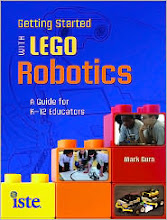Even thought its great that kids get to learn Robotics in school, how wonderful that they also have the opportunity to learn at home. This variety from Mattel is to be offered at a variety of retail outfits. How great it will be when kids commonly come to school already knowing a good deal about robots ...and school, instead of them starting them at square one, builds on their homegrown knowledge and takes them... much further!
Very nice review (below) from TechCrunch: https://techcrunch.com/2017/10/11/mattel-releases-biologically-inspired-foldable-robot-toys/
Very nice review (below) from TechCrunch: https://techcrunch.com/2017/10/11/mattel-releases-biologically-inspired-foldable-robot-toys/
"Mattel releases biologically inspired foldable robot bugs
Mattel’s been taking great pains to
update its product lines for a plugged-in generation of kids. Last month, the toy maker teamed up with Osmo
for an iPad-ready update to its popular Hot Wheels line, and now the company is
enlisting the help of another tech startup, Dash Robots. The pair’s
first collaboration is Kamigami, a robotics platform that lets kids build
their own robotic bugs.
Due out on Target store shelves
today, the toy features a six-legged robotic kit that should take roughly an
hour to assemble, using foldable plastic sheets. Each also comes with a
different origami shell that turns them into various bugs, like mantises,
ladybugs and scorpions.
Both Dash and its first major
consumer product are an outgrowth of U.C. Berkeley’s Biomimetic Millisystems
Lab, which draw inspiration from nature to build more efficient robotics.
“We had shown off our robots at
schools and outreach events to show off what robotics research is like,”
cofounder Nick Kohut tells TechCrunch. “Kids just went totally nuts for them
and the parents were asking where they could buy them. So we started selling
them on our own and had some mild success.”
Dash began life as a UCB spinoff by
selling its own kit for $65 a pop, ultimately teaming up with Mattel to help
mainstream the product. For obvious pricing and kid-friendly reasons,
Kamigami isn’t particularly complex, as far as biomimetic robots go, but the
product does draw inspiration from its biological counterparts. The connection
is particularly apparent in the product’s locomotion, using a stiff-legged gait
to move quickly across a surface.
Each $50 robot features an
accelerometer, gyroscope and an IR transmitter and receiver that allow them to
interact with their surroundings and one another for games like freeze tag and
“sumo,” in which they relentlessly bash into one another. They can also be
controlled remotely through the mobile app, or preprogrammed with a basic
coding application designed to teach some programming basics..."






